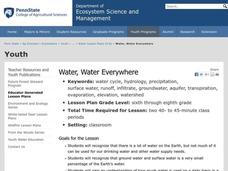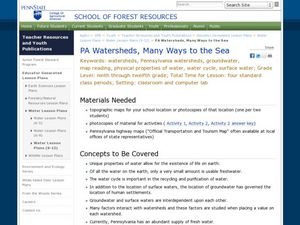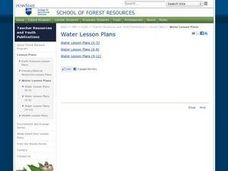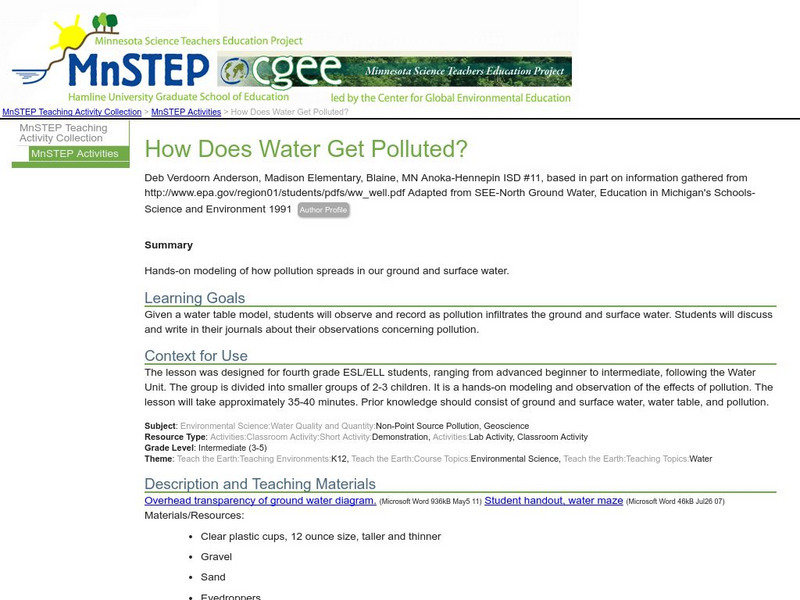Curated OER
Identifying Pennsylvania Watersheds
Ninth graders study and identify the six major drainage systems in Pennsylvania. In this watershed lesson students read an article, complete an activity and take a quiz on what they learned.
Curated OER
Water, Water Everywhere
Students recognize that all of the water on earth cannot be used for drinking and that the percentage of ground and surface water is a small percentage. In this water lesson students identify ways to conserve water.
Curated OER
PA Watersheds, Many Ways to the Sea
Students examine the water cycle and the factors that interact with watersheds. For this watersheds lesson students describe the purification process, trace the flow of infiltrate water through aquifers, and research the Internet...
Curated OER
Settling The Wasterwater Problem
Students name models that are representations of larger objects. They suggest ways that industry, agriculture, and mining affect water quality. Pupils demonstrate the use of lagoons for treating wastewater. Students define the...
Curated OER
Lesson 3 - Water Above the Ground
Students define surface water, drainage basin or watershed. They investigate what affects runoff in a drainage basin. They complete lab sheets and worksheets.
Curated OER
Water Resources
Students explore the differences between surface water and ground water. They collect data using maps and graphs and investigate a Texas river basin and a nearby aquifer. They complete a written report of their findings regarding the...
Curated OER
On the Surface
Students draw and label the 15 major rivers in Texas. They then draw and label another map with the major lakes and reservioirs of Texas. Students use the maps and locate and label the location of the following major Texas cities:...
Curated OER
Water Above the Ground
Students create a river drainage basin using a plastic tub, sand and a pitcher of water. They simulate the flow of water through the basin then add chocolate syrup to model what would happen if stormwater pollution entered the basin.
Curated OER
"Pennsylvania Watersheds, Many Ways to the Sea"
Pupils trace a molecule of water through the water cycle including each of its three loops. They describe why evapotranspiration demands the largest portion of total precipitation falling on a forested watershed.
Idaho State University
Idaho State University: Surface Water Process, Supply and Use
This environmental geology resource identifies the significance of our land's surface water. Review the sources of water and how they are processed and used.
Science Buddies
Science Buddies: Career Profile: Hydrologist
The career of hydrologist could become more and more important as the use of water increases. Find out about the education needed to become a hydrologist and read the Science Buddies profile about the many areas hydrologists use their...
US Geological Survey
Usgs: Water Use in the United States
This thorough site delves into how we use water on an everyday basis. Ground water, surface water, domestic use, commercial use, irrigation use, are just a few of the topics described on this site. Click Home to access the site in Spanish.
US Geological Survey
Usgs: Water Science for Schools Water Science Storytime!
This U.S. Geological Survey website features a fictious town, Dryville, and uses it to illustrate every aspect of water management that you might encounter. Click Home to access the site in Spanish.
TeachEngineering
Teach Engineering: Natural and Urban Stormwater Water Cycles
Through an overview of the components of the hydrologic cycle and the important roles they play in the design of engineered systems, students' awareness of the world's limited fresh water resources is heightened. The lesson lays the...
Texas Education Agency
Texas Gateway: Human Impact
This tutorial provides some insight to the study of human impacts on water supplies.
US Geological Survey
U.s. Geological Survey: Water Resources of the United States
Visit the U.S. Geological Survey's website for a wide variety of information on water. Content includes data on water quality, water use, acid rain, among others; publications; information on water resource programs; maps; information on...
US Geological Survey
U.s. Geological Survey: Water Science for Schools
A collection of resources--pictures, maps, data, glossary--about water and the water cycle.
Annenberg Foundation
Annenberg Learner: The Habitable Planet: Water Resources
Learn about water as a precious resource in danger of being depleted. Understand the roles that overuse and agricultural use play in the sustainability efforts of this essential resource. Includes video. [28:25]
Other
Virtual Field Trip: Water/aquifers
This virtual field trip for middle school students looks at aquifers and their place in the hydrologic cycle. Students learn why and how it is important to protect the source of your drinking water and some unique details about the...
US Geological Survey
Usgs: Water Science Glossary of Terms
The United States Geological Survey offers a complete look at water science in glossary form. Take advantage of the topic guides at the top of the site. You'll find great maps, clipart and activities centers. Click Home to access the...
US Geological Survey
U.s. Geological Survey: What Is the Water Cycle?
A quick summary of the water cycle that includes a diagram of the cycle, with links to in-depth explanations of each component of the cycle. Click "water-cycle home" to access water-cycle resources in a variety of languages.
Center for Educational Technologies
Nasa Classroom of the Future: Florida Everglades
This site is full of information and activities to help learn about the Florida Everglades, a unique wetland environment, and its future.
TED Talks
Ted: Ted Ed: Anupam Mishra: The Ancient Ingenuity of Water Harvesting
Video lesson shares information about water harvesting structures used in India today. Anupam Mishra talks about the superiority of these structures built by the people of India's Golden Desert centuries ago compared to modern water...
Science Education Resource Center at Carleton College
Serc: How Does Water Get Polluted?
Given a water table model, students will observe and record as pollution infiltrates the ground and surface water.




















